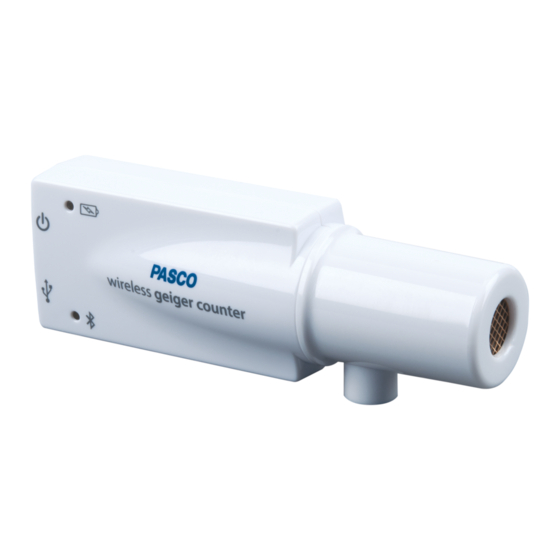
Table of Contents
Advertisement
Quick Links
Wireless Geiger Counter
What's Included
• Wireless Geiger Counter
• Threaded handle
• USB cable
Features
Battery status light
Indicates the status of the Bluetooth connection.
Light
Red, blink
Yellow, solid
Green, solid
Power button
Turn the sensor on or off by pressing the power button until
the lights turn on. Turn the audible count indicator beep on
or off by pressing the power button for a half-second; two
beeps indicate that the audible count indicator beep is
turned off, and one beep indicates that it is turned on.
USB port
Charge the battery by connecting the USB port to a USB
wall charger using the USB cable. You can also use the
USB cable to connect the Wireless Geiger Counter to a PC,
Mac, Chromebook, or Android device.
Status
Low battery level
Charging
Fully charged
(PS-3238)
Bluetooth status light
Indicates the status of the Bluetooth connection or remote
logging. See the SPARKvue or PASCO Capstone help for
instructions on using remote logging.
Light
Red, blink
Green, blink
Yellow, blink
Device ID
Use the device ID to identify the sensor when connecting
using Bluetooth.
Threaded hole
Attach the threaded handle to the hole for mounting the
sensor to a rod stand.
Sensor window
Place a radioactive sample in front of the window to detect
alpha, beta, and gamma particles. A built-in metal mesh
screen protects the mica window in front of the Geiger-
Müller detector tube.
First use tasks
Perform the tasks in this section before using the sensor with
students. You should also perform these tasks at the beginning
of each semester to minimize disruptions.
Charge the battery
Charge the battery by connecting the USB port to any standard
USB charger. The battery status light is solid yellow while
charging. When fully charged, the light changes to solid green.
Get the software
You can use the sensor with SPARKvue or PASCO Capstone
software. If you're not sure which to use, visit
pasco.com/products/guides/software-comparison.
SPARKvue is available as a free app for Chromebook, iOS, and
Android devices. We offer a free trial of SPARKvue and
Capstone for Windows and Mac. To get the software, go to
pasco.com/downloads
or search for SPARKvue in your device's
app store.
If you have installed the software previously, check that you have
the latest update:
SPARKvue
Go to Main Menu
> Check for Updates
PASCO Capstone
Go to Help > Check for Updates.
Product Guide | 012-16913B
Status
Ready to pair
Paired
Remotely logging data
1
Advertisement
Table of Contents

Summary of Contents for PASCO PS-3238
- Page 1 When fully charged, the light changes to solid green. Get the software Battery status light Indicates the status of the Bluetooth connection. You can use the sensor with SPARKvue or PASCO Capstone software. If you’re not sure which to use, visit Light Status pasco.com/products/guides/software-comparison.
- Page 2 Follow these procedures to begin collecting data from the these readings update continuously instead of only at the Wireless Geiger Counter using SPARKvue or PASCO Capstone. end of each sample. (See "Count Types" for an explanation of the different measurements offered by the Wireless SPARKvue Geiger Counter.)
- Page 3 The sensor can be mounted in the following ways: including step-by-step instructions on using the sensor with the software, see the SPARKvue or PASCO Capstone help: • Insert the sensor into the Geiger Counter Sample Holder (NU-3344). This option provides superior position control SPARKvue for inverse square law and radiation shielding labs.
- Page 4 PASCO scientific, is prohibited. Trademarks PASCO and PASCO scientific are trademarks or registered trademarks of PASCO scientific, in the United States and in other countries. All other brands, products, or service names are or may be trademarks or service marks of, and are used to identify, products or services of, their respective owners.















Need help?
Do you have a question about the PS-3238 and is the answer not in the manual?
Questions and answers